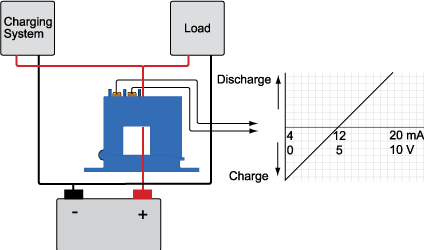AC Current
A current transducer is a cost effective method to measure the work being done by a process and detect potential issues  before they become catastrophic breakdowns. A clogged intake or loss of head pressure in a pump system will cause the drive motor to use less current than normal. The same condition occurs if the discharge is open, which in a sewage lift station means immediate intervention is required.
before they become catastrophic breakdowns. A clogged intake or loss of head pressure in a pump system will cause the drive motor to use less current than normal. The same condition occurs if the discharge is open, which in a sewage lift station means immediate intervention is required.
A failing bearing will cause the motor to draw more than normal current; using a current sensor will notify the operator of a problem long before the overload protection in the starter will react. Additionally, a current transducer can be used to shut down the system, if the system designer so chooses.
Many AC motors are driven with variable speed drives to save energy, and while the output is much cleaner with regard to  the wave shape, none are sinusoidal. A RMS responding sensor will produce a signal directly proportional to the current used, and this can be connected to a second drive to match speed or work loading.
the wave shape, none are sinusoidal. A RMS responding sensor will produce a signal directly proportional to the current used, and this can be connected to a second drive to match speed or work loading.
Monitoring a heating load controlled by phase angle fired SCR’s accurately also requires RMS sensing, but a simple current switch or relay will detect whether an element has failed without the latency resulting from monitoring temperature only.
AC Power
Monitoring current only might not be enough, if the pump or drive motor runs at low power factor. Monitoring power will produce a signal directly proportional to the watts (work) being used. NK Technologies' APS sensor is a very compact, self contained device that will do this job perfectly. One phase is passed through a single aperture from left to right, another from right to left, and both monitored phases are connected to the circuit voltage. With this unique method of field wiring, the sensor measures the current and voltage continuously, and produces a 4–20mA loop-powered signal which represents the true power, not just voltamperes.
DC Current
DC Systems are becoming more and more common, with photovoltaic panels on many more homes and businesses. The advantages  over current shunts are many: There is no need to cut and terminate the conductor, the non-contact nature of the sensor adds to burden to the system, and temperature changes cause much lower error. NK Technologies manufactures DC current transducers with ranges from 0–5 to 0–2000 amps, with a variety of outputs available to interface with panel meters, programmable logic controllers or building energy management systems.
over current shunts are many: There is no need to cut and terminate the conductor, the non-contact nature of the sensor adds to burden to the system, and temperature changes cause much lower error. NK Technologies manufactures DC current transducers with ranges from 0–5 to 0–2000 amps, with a variety of outputs available to interface with panel meters, programmable logic controllers or building energy management systems.
The sensors can be used to monitor any DC voltage to 600 and still carry the UL logo, allowing your panel design to be safe and accurate in the widest variety of applications.
Whether the load uses a battery as a backup or the primary source and current flow direction must be known, or a welding operation is to be monitored and studied, NK Technologies has a sensor with the range, accuracy and reliability you need and your customers demand.
